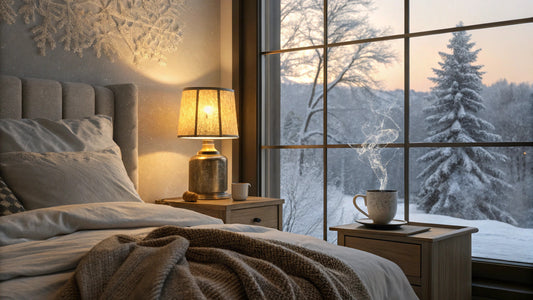
The Perfect Bedroom Setup for Deep, Restful Sleep
Sleep isn’t just about quantity—it’s about quality. A well-designed bedroom can make the difference between tossing and turning and sinking into deep, restorative rest. Below, you’ll find clear, science-backed answers on how to set up your bedroom for the best possible sleep.
What temperature and lighting are ideal for deep, restful sleep?
Answer: The ideal bedroom temperature is between 16–20 °C (60–68 °F), paired with dim, warm lighting or blackout curtains to keep your circadian rhythm on track.
-
Temperature: A cooler room helps your body naturally lower its core temperature, which is necessary for deep slow-wave sleep.
-
Lighting: Use blackout curtains or an eye mask to block light. For lamps, choose bulbs in the warm/amber spectrum.
-
Why it matters: Light and temperature are the strongest environmental cues that regulate melatonin production and sleep cycles.
How should I choose the right mattress, pillows, and bedding?
Answer: Select a medium-firm mattress, pillows that support your preferred sleep position, and breathable, natural bedding like cotton, linen, or bamboo.
-
Mattress: Medium firmness often balances comfort with spinal alignment.
-
Pillows: Side sleepers benefit from thicker, supportive pillows; back sleepers may prefer flatter ones.
-
Bedding: Natural fibers regulate temperature and wick away moisture, keeping you cool and comfortable throughout the night.
A mismatched mattress or bedding can fragment your sleep by causing overheating or discomfort.
What noise and electronic setups support restorative sleep?
Answer: A quiet bedroom—aided by white noise if necessary—and minimizing electronic devices helps protect deep sleep stages.
-
Noise: If your environment is noisy, try white noise machines, fans, or earplugs.
-
Electronics: Keep phones and TVs out of the bedroom when possible. At minimum, enable night mode to reduce blue light.
-
Why it matters: Exposure to blue light from screens in the evening suppresses melatonin, delaying sleep onset. Harvard Health notes that evening screen light can significantly disrupt natural sleep cycles.
How can room layout and decluttering improve sleep quality?
Answer: A tidy, minimalist layout with clear boundaries between work and rest creates a calming environment that primes your brain for sleep.
-
Remove clutter from nightstands and visible surfaces.
-
Keep desks or work equipment out of the bedroom if possible.
-
Add calming touches—like plants or soft textiles—without overstimulating the space.
Your bedroom should signal one thing: rest.
FAQs
Q: What’s the best fabric for pillowcases?
A: Silk or high-thread-count cotton pillowcases help reduce skin friction and overheating.
Q: Should I use a weighted blanket?
A: Weighted blankets (7–12% of your body weight) can ease anxiety and promote deep sleep, but they aren’t comfortable for everyone.
Final Thoughts
Designing the perfect bedroom for deep, restful sleep isn’t about luxury—it’s about aligning your environment with your body’s natural rhythms. Keep it cool, dark, quiet, and clutter-free, and choose bedding that supports comfort without overheating. These small changes can transform the quality of your rest and, by extension, your energy, focus, and mood during the day.



